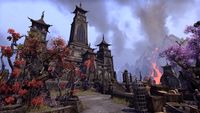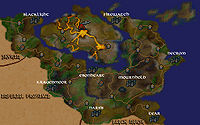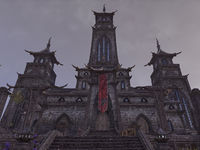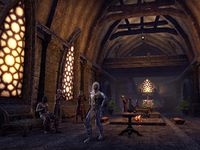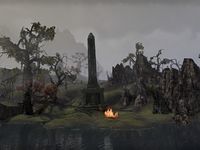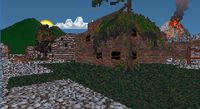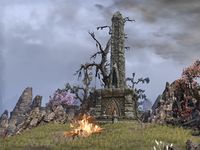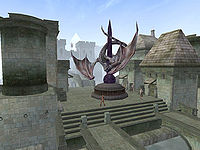Lore:Ebonheart
This article is about the city. For the castle, see Castle Ebonheart.
| Ebonheart | |
|---|---|
| Type | Settlement |
| Continent | Tamriel |
| Province | Morrowind |
| Region | Stonefalls (Zabamat) |
| Appears in | Arena, ESO |
|
Ebonheart (also called Old Ebonheart)[1] is one of the eight major cities on the mainland of Morrowind,[2] and is located in the center of Stonefalls.[3] The city is considered the eldest city-state in the province and is more commonly known as the ancestral seat of the Ra'athim Clan,[4] described by the potentially fictional King Edward book series as an ancient family of Dunmer miners.[5] Some members are well-known across Tamriel, such as Moraelyn, called the "Champion of Tamriel" in the King Edward book series,[6] and Katariah Empress-Regent of the Third Empire.[7]
Layout and Geography[edit]
Ebonheart is found on the north-central coast of Stonefalls, in a strategic location on the Inner Sea.[3] The city was the seat of power of a country led by the Ra'athim Clan, one that spanned many mining fiefdoms and encompassed what became modern-day Mournhold. Historically, the Ra'athim Clan's parent faction, House Mora was absorbed into the greater House Hlaalu, which places it in Great House's district.[4] But in the mid-Second Era, the city was affiliated with House Dres, whose leadership was centralized in the Stonefalls region via Kragenmoor.[3][8] Ebonheart is neighbored by several settlements, including Darnim Watch to the east, Eagle Moor to the southeast, Mournhold to the east-southeast, Old Keep to the far southeast, Riverbridge to the southwest, and Stonefalls to the northwest.[2]
Beyond the walls lies the ash wastes and the ridged hills of the mountains, where only the local Ashlanders and mining prospects flourish. The majority of the city proper is built on an island, nestled in the large river basin next to the inactive volcanic spire, Ash Mountain, and the aforementioned river, which comes from the south.[3] While some maps show the river going as far south as south-central Morrowind, near Narsis,[2][nb 1] others indicate that it starts in the mountain valley called the Brothers of Strife and descends downward into the river basin.[9] For the longest, Dreughs were common around Ebonheart, Vvardenfell, and the surrounding waters but have been driven out over centuries and now live in small, isolated pockets.[10]
The city is surrounded by large stone walls and its exterior is open land where people tend to set up encampments. At the center of the city is the seat of power, Castle Ebonheart, which sits on a stone foundation that overlooks the waterfront and the local Argonian Quarter. The south side of the castle contains the local city plaza and parkland, right in the middle of the main street that is anchored by the local Temple to the west and the local cornerclub to the east. Around the castle are two steep staircases that lead into the Argonian Quarters, lowland with wooden planks and ashreeds on the side of the road. At the center of it all lies their Hist Tree.[3] According to the historical-fiction, 2920, The Last Year of the First Era, the Tribune of Sorcery, Sotha Sil has a hidden laboratory in the smoky catacombs underneath the city, where he "forged the future with his arcane clockwork apparatus."[11]
Notable Locales[edit]
|
Districts[edit]
History[edit]
Early History[edit]
Ebonheart is considered the eldest city-state in Morrowind and its rivalry with Mournhold to the south has existed since the dawn of the province's history. Before they were separate settlements, they were part of one fief led by the Ra'athim Clan. In these early days, the clan was associated with House Mora, a minor house that eventually became part of House Hlaalu.[4] When the Conquest of Morrowind took place in the early First Era, many places such as Ebonheart were taken over by the Nords. In the potentially fictional King Edward book series, Kronin and his sons Cruethys, S'ephen, and Moraelyn became raiders and took up guerrilla warfare to fight against their oppressors.[15] The Nords held the city for a century and a half[16] but its original rulers returned to their post after Resdayn had been liberated in 1E 416.[15][17]
According King Edward, sometime after the conflict, Ebonheart was ruled by King Cruethys, who later died when the council chambers collapsed onto him.[16] His brother, Moraelyn took up his role afterward, and in his possession were the Horn of Summoning and the Staff of Chaos; items of immense power. He placed these artifacts under Ephen's protection and it was hence bound to his tomb underneath Mournhold. Moraelyn's daughter, Lian took his place later and her sons were left as joint heirs to the throne. The schism left both Ebonheart and Mournhold as separate states.[4]
Ebonheart in the Second Era[edit]
By the mid-Second Era, Ebonheart was nominally ruled by House Dres[18] while other houses had a significant presence in town, such as House Hlaalu and House Redoran. In 2E 572, after the Battle of Vivec's Antlers, which ended the Second Akaviri Invasion, leaders of the defending Argonian, Dunmer, and Nord forces gathered in Ebonheart to formulate their alliance now known as the Ebonheart Pact.[19]
In 2E 582, the Daggerfall Covenant invaded the Stonefalls region and landed in Vivec's Antlers to the west of the city, where they planned their invasion of the city led by Alexandra Conele. At the time, three factions were present in Ebonheart, the Dark Elves, the Argonians, and the Nords visiting from the Rift but each of them was unwilling to fight together and defend the city. Drathus Othral decided to employ an Agent of the Pact to reconcile these factions and help them with whatever problem ails them. Over the course of their quest, they learned that a Dark Elf named Rhavil Urano was responsible for their troubles and discovered their allegiance to the Daggerfall Covenant. With the threat neutralized, Ebonheart was able to band together for an impending invasion.[20]
Ebonheart in the Third Empire[edit]
After the Armistice had been signed, the old noble families of Morrowind were gone, and new people, some of whom were upstarts like Symmachus attained power over the land. While Tiber Septim took the Horn of Summoning from Ephen's tomb, he left the Staff of Chaos in Morrowind's protection. Ebonheart argued against this decision by using their status as the ruling house to get the staff. But Mournhold reminded them it was Moraelyn, who left it in Ephen's protection and Mournhold was undeniably his birthplace.[4]
Symmachus, with help from a rag-tail end of the Ra'athim Clan, hid the Staff of Chaos in Ephen's tomb, where it remained for several years. For that service, he was granted the kingship of Ebonheart and continued to rule there for many years.[12] Over time, however, the kingdom became jealous that the staff was kept in Mournhold instead of with them. According to the historical fiction, "The Real Barenziah", the councilors in Ebonheart picked at the city's bones and sucked them dry, something that Symmachus wanted to prevent for Mournhold.[4]
Over the course of her career, Queen Potema of Solitude gathered allies across the northern tier of Tamriel, from High Rock to northern Morrowind,[21][22] which included Ebonheart. When the War of the Red Diamond commenced, the city rallied its arms and fought the Third Empire. It was a poorly-kept secret at the time that they supported Potema and her son, Uriel III. Since then, the Empire slowly healed as Emperor Magnus Septim spent much of his reign mending diplomatic wounds created by the war. Scholars believe that, as a means to cement relations with Ebonheart, he proposed the marriage between his son, Pelagius III and the heiress to the Ra'athim Clan, Katariah.[7]
During the Imperial Simulacrum in the late Third Era, the city-state of Ebonheart was an active settlement. It was ruled by King Casik, who acquired a reputation for his extreme ruthlessness at the time. Ebonheart had a rivalry with several other cities, namely Blacklight, Firewatch, Kragenmoor, and Mournhold.[23] In the latter years of this decade, the Eternal Champion traveled to Morrowind to seek out the lost mines of Dagoth-Ur, where the last piece of the Staff of Chaos was located. Local rumors eventually brought them before King Casik, who offered the dungeon's whereabouts in exchange for a quest.[24]
If they were to retrieve the lost Hammer of Gharen from Black Gate, then he could strike on the Anvil of Mithas and thus have it reveal Dagoth-Ur's location. Just as he predicted, Casik was able to procure the dungeon's location and with it, the Eternal Champion was able to find the last piece of the Staff.[24] With knowledge of the mine's location, King Casik hoped to harvest raw metals from the mountain and unearth the lost art of Dwarven smithcraft for his people to create the greatest weapons in the realm.[25] Ever since the Eternal Champion defeated Jagar Tharn, many subjects of the Empire partake in a pilgrimage across the continent, retracing their steps from the quest. Loyalist pilgrims make their way through Ebonheart.[26]
Known Rulers[edit]
—A quote oft-expressed by Ebonheart's rulers[4]
For many years, Ebonheart was ruled by the Ra'athim Clan, a family that once held the role of High Kingship in the province.[Note 2] They were affiliated with the minor House of Mora, which was eventually absorbed into the Great House Hlaalu.[12][27] Over the course of history, other people had control over the city. For a century and a half, the Nords of Skyrim held Ebonheart during the Conquest of Morrowind. Who led at this time is currently unknown, but according to the King Edward book series, the Ra'athim Clan retook it[15] after the Nords were defeated in 1E 416.[17]
Their territory encompassed Ebonheart and Mournhold until joint heirs were appointed to each respective city and since then they have been separate entities. At the time they ruled, the High Kingship was also vacant when a temporary war leader was elected.[4] In the mid-Second Era, House Dres governed the city from the manor in the center of town[18] but by the Third Era, the Ra'athim Clan returned to the throne.[7][12]
- The First Era
- High King Kronin Ra'athim[15]
- High King Cruethys Ra'athim[16][28]
- High King Moraelyn "the Witch-King" Ra'athim (ca. 1E 369)[12]
- High Queen Lian Ra'athim[4]
- King Ra'athim of Ebonheart — This monarch was the first to lead Ebonheart after Mournhold separated itself from the Ra'athim's fiefdom. "The Real Barenziah" claims that a temporary war leader was decided at the time, thus leaving the High Kingship vacant.[4]
- Duke of Ebonheart (ca. 1E 2920)[29]
- The Second Era
- The Third Era
- King Ra'athim of Ebonheart (fl. late Second Era – 3E 376) — This monarch helped Symmachus hide the Staff of Chaos underneath Mournhold shortly after Tiber Septim took over Morrowind. Symmachus in the book, "The Real Barenziah" states that the Ra'athim clan member was now the King of Ebonheart by the time the Staff of Chaos was stolen[12] and Barenziah would conceive Helseth months later,[4] in 3E 376.[30]:15
- King Casik (fl. 3E 389 – 3E 399)[23]
Culture and Society[edit]
Ebonheart is known by a couple of other names. Colloquially it is called the Black City, which mirrors one of Vvardenfell's names, the Black Isle.[23] Divayth Fyr also referred to the city as the One True Ebonheart.[31] A local dish in Ebonheart are blackened snake hearts.[32] Unlike most other cities, Ebonheart is open-minded when it comes to interring dead outlanders, though it is more likely to find a tomb with multiple names on a plaque than a private grave.[33]
One fateful day, Vivec visited Ebonheart in the mid-Second Era and became enthralled by its architecture, wandering its streets for hours and studying every bit of it. He developed a desire to have it moved or built in a spot south of Vivec City in Vvardenfell. The Archcanon at the time, Tarvus wrote to the Tribunal Temple and House Hlaalu engineers about Vivec's inquiries about a new project.[34] While the outcome of this is unknown, the Third Empire would build their own fort-town west of Vivec's Palace also called Ebonheart after the trade and settlement ban on Vvardenfell was uplifted.[35]
The mainland city has reverence for the Tribunal. The three gods had previously gone through Ebonheart on their annual pilgrimage to Vvardenfell.[36] Shrines to each of the gods anchor the city in three points, with Vivec and Almalexia's shrines on the southwest and east corners respectively, while Sotha Sil's shrine marks the northernmost point of the city.[37] Castle Ebonheart at the center of town is inspired by the Tribunal as the three-spired structure is emblematic of this.[13]
For a short time, the court of Ebonheart declared dancing to be illegal and the locals protested by inventing the Lava Foot Stomp, which they called a necessity if their boots ever catch flame. They would practice it in taverns while wearing a dazzling pin. Since then, it has become a New Life tradition and practiced across Stonefalls, from Ebonheart to Davon's Watch.[38] "The Real Barenziah" associates the Nightingale with Ebonheart and the Ra'athim Clan.[4]
Gallery[edit]
-
Castle Ebonheart in Vvardenfell (Morrowind)
Notes[edit]
- Arena was originally conceived as a fighting game featuring a tournament that took the player to each of Tamriel's cities to challenge different gladiatorial teams. According to a file from that stage of development left behind in the final game, Ebonheart's gladiatorial team would have been called "the Reavers".[UOL 2]
See Also[edit]
- For game-specific information, see the Arena and Elder Scrolls Online articles.
Books[edit]
- On Moving Ebonheart by Archcanon Tarvus — A missive on the creation of a new city
- Posted at the Ebonheart gates — A notice regarding dangerous alit around Ebonheart
References[edit]
- ^ Heirloom Ebony Ash Yam Slow Cooker contraband text in ESO
- ^ a b c Map of Morrowind – The Elder Scrolls: Arena
- ^ a b c d e f g h i j k l m n o p Ebonheart in ESO
- ^ a b c d e f g h i j k l The Real Barenziah, v 5 — Anonymous
- ^ King Edward, Part VII — Anonymous
- ^ King Edward, Part 2 — Anonymous
- ^ a b c The Madness of Pelagius — Tsathenes
- ^ The Improved Emperor's Guide to Tamriel: Stonefalls and Deshaan — Flaccus Terentius, 2E 581
- ^ Map of Stonefalls – The Elder Scrolls Online
- ^ Notes on the Dreugh
- ^ a b 2920, Evening Star — Carlovac Townway
- ^ a b c d e f The Real Barenziah, v 4 — Anonymous
- ^ a b A Travel Guide to Tamriel Castles — Astinia Isauricus
- ^ Nilthis' dialogue in ESO
- ^ a b c d King Edward, Part X — Anonymous
- ^ a b c King Edward, Part XII — Anonymous
- ^ a b Pocket Guide to the Empire, 3rd Edition: All the Eras of Man, A Comprehensive History of our History — Imperial Geographical Society, 3E 432
- ^ a b c Drathus Othral's dialogue in ESO
- ^ Unexpected Allies
- ^ Restoring Order quest in ESO
- ^ Brief History of the Empire v 2 — Stronach k'Thojj III
- ^ The Wolf Queen, v6 — Waughin Jarth
- ^ a b c Ebonheart location and rumors in Arena
- ^ a b Dagoth-Ur story quest in Arena
- ^ King Casik's dialogue in Arena
- ^ A Minor Maze
- ^ Interview With Three Booksellers — Jobasha, Codus Callonus, and Dorisa Darvel
- ^ King Edward, Part IV — Anonymous
- ^ 2920, Morning Star — Carlovac Townway
- ^ The Daggerfall Chronicles — Ronald Wartow
- ^ Return of a Fellow Scholar — Divayth Fyr
- ^ Elam Dral's dialogue during Contract: Stonefalls in ESO: Dark Brotherhood
- ^ Loremaster's Archive - House Telvanni — Divayth Fyr
- ^ On Moving Ebonheart — Archcanon Tarvus
- ^ A Short History of Morrowind — Jeanette Sitte
- ^ Disciple Sildras' dialogue in ESO
- ^ Night of the Soul quest in ESO
- ^ Breda's dialogue in ESO
- ^ King Llethan's death generic dialogue in Morrowind: Tribunal
Note: The following references are considered to be unofficial sources. They are included to round off this article and may not be authoritative or conclusive.
